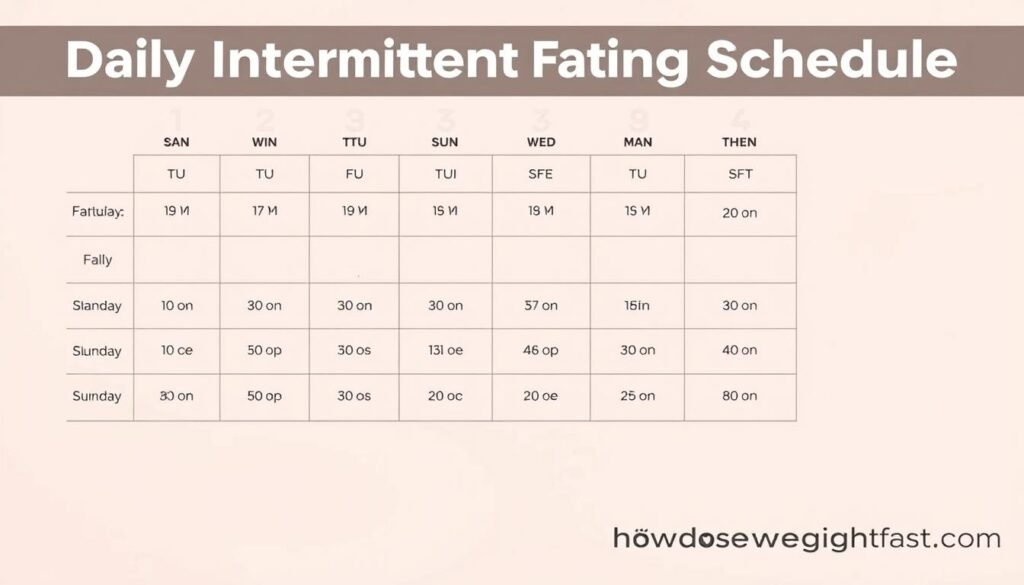Intermittent Fasting Schedule for Fast and Effective Weight Loss
As Hippocrates once said, “Let food be thy medicine and medicine be thy food.” This timeless wisdom resonates deeply with the concept of structured eating patterns, a method gaining traction for its ability to transform health and wellness.
Intermittent fasting is more than just a trend; it’s a scientifically-backed approach to managing your weight. By alternating between eating and fasting windows, your body taps into stored fat for energy, accelerating fat burning while keeping you energized throughout the day.
Studies from trusted institutions like the Cleveland Clinic and Season Health validate its effectiveness. Beyond weight loss, this method can improve metabolism, simplify meal planning, and promote long-term health. The best part? It’s adaptable to your lifestyle, ensuring sustainable results.
Key Takeaways
- Structured eating patterns can boost fat burning and energy levels.
- Scientific studies support the effectiveness of this approach.
- Improved metabolism is a key benefit of this method.
- Meal planning becomes simpler and more manageable.
- Personalized schedules ensure long-term success.
What Is Intermittent Fasting?
What if the key to better health lies not in what you eat, but when you eat? This is the foundation of intermittent fasting, a method that alternates between periods of eating and fasting. Unlike traditional diets that focus on calorie restriction, this approach emphasizes timing.
Understanding the Basics
Intermittent fasting involves intentional time-restricted eating patterns. During fasting windows, you can still drink water, black coffee, or tea. This method shifts your body’s energy source from glucose to stored fat, promoting fat burning and improved metabolism.
How It Differs from Traditional Diets
Traditional diets like keto or Mediterranean focus on what you eat, often requiring strict calorie counting. In contrast, intermittent fasting is about when you eat. It’s flexible, allowing you to choose methods like the 16/8 or 14/10 approach based on your lifestyle.
This isn’t about starvation; it’s about strategic fuel management. By aligning your eating patterns with your body’s natural rhythms, you can achieve sustainable results without feeling deprived.
Why Choose Intermittent Fasting for Weight Loss?
Ever wondered how timing your meals could transform your health journey? Structured eating patterns can help your body shift from burning glucose to stored fat, making it a powerful tool for weight loss. This method isn’t just about skipping meals—it’s about optimizing your body’s natural processes.
The Science Behind Weight Loss
When you go without food for 12+ hours, your body depletes its glycogen stores and enters ketosis. This process, known as fat adaptation, allows your body to burn fat for energy. Studies from Season Health show that this shift can improve metabolic flexibility, helping you manage your weight more effectively.
Additionally, this approach reduces insulin spikes, which can curb cravings and prevent nighttime snacking. By stabilizing your blood sugar, you’re less likely to experience energy crashes or overeat.
How It Helps You Shed Pounds Faster
One of the key benefits is appetite regulation. Reduced ghrelin production—the hormone that signals hunger—makes it easier to stick to your eating windows. For example, the 5:2 method, which involves consuming only 500 calories on two non-consecutive days, has been shown to boost fat loss.
Research from the Cleveland Clinic highlights improved BMI in participants who followed structured eating patterns. By aligning your meals with your body’s natural rhythms, you can achieve sustainable results without feeling deprived.
Benefits of Intermittent Fasting
Structured eating patterns offer more than just weight loss—they can transform your overall health. By aligning your meals with your body’s natural rhythms, you unlock a range of benefits that go beyond the scale. From improved blood sugar levels to enhanced energy, this approach supports your well-being in multiple ways.
Improved Blood Sugar Levels
One of the most significant benefits is better blood sugar control. Studies show a 12% average improvement in HbA1c levels among prediabetic patients. By reducing insulin spikes, this method helps stabilize your blood sugar, preventing energy crashes and cravings.
Enhanced insulin sensitivity is another key advantage. This means your body uses insulin more efficiently, reducing the risk of type 2 diabetes. It’s a proactive step toward long-term health.
Enhanced Energy and Focus
When your body shifts to burning fat for fuel, it produces ketones, which boost mental clarity and focus. This process, known as ketosis, can leave you feeling more alert and energized throughout the day.
Additionally, autophagy—a cellular cleanup process—activates after 16+ hours without food. This not only supports brain function but also has anti-aging benefits, keeping your cells healthy and efficient.
Reduced Inflammation
Chronic inflammation is linked to numerous health issues, from heart disease to arthritis. Research from the Cleveland Clinic shows a 34% reduction in inflammation markers with this approach. By calming inflammation, you support your immune system and overall well-being.
Improved gut health is another perk. A balanced eating routine promotes a healthier gut microbiome, which plays a crucial role in digestion and immunity. Clinical observations also highlight its potential to lower hypertension, making it a holistic choice for better health.
Popular Intermittent Fasting Schedules
Finding the right eating pattern can make all the difference in your health journey. There are several methods to choose from, each with its own unique approach. Whether you prefer a shorter eating window or a more flexible plan, there’s an option that fits your lifestyle.
The 16/8 Method
This method involves eating within an 8-hour window and fasting for the remaining 16 hours. For example, you might eat between noon and 8 PM. This approach is great for those who skip breakfast and prefer larger meals later in the day.
It’s easy to adapt to social events, as your eating hours align with typical meal times. Many find this method sustainable because it doesn’t require drastic changes to their routine.
The 14/10 Method
Ideal for beginners, this plan includes a 10-hour eating window and a 14-hour fast. For instance, you could eat from 9 AM to 7 PM. This method is less restrictive, making it easier to stick to while still reaping the benefits.
It’s a great starting point if you’re new to structured eating. Gradually, you can work your way up to longer fasting periods.
The 5:2 Method
This approach involves eating normally for five days and limiting calories to 500 on two non-consecutive days of the week. It’s a calorie-restricted method that allows flexibility in your eating schedule.
While it’s effective, it may not suit everyone. Some find it challenging to stick to such low-calorie days. However, it’s a good option if you prefer occasional restrictions over daily changes.
Remember, extreme plans like 24-hour fasts can lead to fatigue or headaches. Start with shorter fasts and progress gradually to find what works best for you.
How to Start Intermittent Fasting
Ready to take the first step toward a healthier lifestyle? Starting a structured eating plan can feel overwhelming, but with the right approach, it’s easier than you think. The key is to begin gradually and find a routine that fits your daily life.
Choosing the Right Schedule for You
Not all plans work for everyone. Start with a 12-hour fast and gradually progress to a 14/10 method, as recommended by Season Health. This allows your body to adapt without feeling deprived.
Consider your lifestyle when choosing a plan. Do you prefer eating earlier in the day or later? Are there specific days or times when you’re busier? Answering these questions will help you pick the best approach.
Tips for Beginners
Starting a new routine can be challenging, but these tips will make it smoother:
- Hydrate smartly: Drink water, black coffee, or tea during fasting periods to stay energized.
- Handle hunger pangs: Distract yourself with light activities or sip on electrolyte-rich drinks to curb cravings.
- Track your progress: Use apps or journals to monitor your eating and fasting windows for gradual adjustments.
- Stay consistent: Stick to your chosen meal times to help your body adapt faster.
Remember, it’s okay to start small. Over time, you’ll find what works best for you and your lifestyle.
Intermittent Fasting Schedule for Fast Results
Timing your meals strategically can unlock your body’s potential for better health and weight management. By aligning your eating patterns with your body’s natural rhythms, you can maximize the benefits of this approach. Let’s explore how to optimize your routine for the best outcomes.

Optimizing Your Eating Window
Choosing the right window for your meals is crucial. For example, having an early dinner before 6 PM can enhance fat oxidation, helping your body burn fat more efficiently. This simple adjustment can make a significant difference in your results.
Another tip is to avoid artificial sweeteners during fasting hours. These can break your fast and disrupt the benefits of your eating pattern. Instead, focus on natural appetite suppressants like apple cider vinegar, which can help you stay on track.
Maximizing Fat Burn
To boost fat burn, consider extending your fasting period to 18 hours. Studies show this can increase ketone production by 27%, helping your body shift into fat-burning mode more effectively. Pair this with morning workouts to amplify the effects.
Strategic protein timing is also key. Consuming protein-rich meals during your eating window helps preserve muscle mass while promoting fat loss. Additionally, cycling your carb intake on feeding days can optimize energy levels and support your goals.
By combining these strategies, you can create a routine that works for you and delivers fast, sustainable results.
What to Eat During Intermittent Fasting
Choosing the right foods can make or break your eating plan. What you consume during your eating window plays a crucial role in how you feel and the results you achieve. Focus on nutrient-dense options that fuel your body and support your goals.
Nutrient-Dense Foods to Include
Start with fiber-rich vegetables like spinach, broccoli, and kale. These keep you full and support digestion. Lean proteins such as chicken, fish, and tofu are essential for muscle repair and energy.
Don’t forget healthy fats like avocados, nuts, and olive oil. They provide sustained energy and help curb cravings. Magnesium and zinc-rich foods, such as pumpkin seeds and dark chocolate, can also boost your overall health.
Foods to Avoid
Processed snacks and sugary drinks are a no-go. They can spike your blood sugar and leave you feeling sluggish. Instead, opt for whole, unprocessed options that nourish your body.
Be cautious with refined carbs like white bread and pasta. These can disrupt your energy levels and make it harder to stick to your plan.
Practical Tips for Success
Planning your meals ahead of time can save you stress. Prepare balanced dishes that include protein, veggies, and healthy fats. For example, a grilled chicken salad with avocado makes a perfect lunch or dinner.
After fasting, ease back into eating with light, easily digestible foods. A smoothie with spinach, banana, and almond milk is a great option. This helps your body adjust without overwhelming your system.
Remember, consistency is key. Stick to your plan, and over time, you’ll see the benefits of making smart food choices.
Hydration and Intermittent Fasting
Staying hydrated is a cornerstone of any health-focused routine, especially when timing your meals. Proper water intake not only supports your body’s functions but also helps you feel your best during fasting periods. Let’s explore why hydration matters and what drinks can keep you on track.
Why Hydration Matters
When you’re not eating, your body still needs fluids to function optimally. Dehydration can lead to fatigue, headaches, and other side effects that make fasting harder. Drinking enough water ensures your energy levels stay steady and your body stays in balance.
Electrolyte supplements can also help prevent fatigue. They replenish essential minerals lost through sweat and keep your body hydrated. Sparkling water is another great option—it can curb cravings and make fasting more manageable.
Best Drinks to Stay Hydrated
Choosing the right beverages is key to staying hydrated. Here are some top picks:
- Water: Aim for at least 8 glasses daily. Add a slice of lemon for flavor.
- Herbal tea: Options like chamomile or peppermint add variety without breaking your fast.
- Bone broth: Perfect for extended fasts, it provides nutrients and keeps you full.
- Coffee: Limit to 2 cups daily to avoid overstimulation.
Watch for signs of dehydration, such as dry mouth or dizziness. If you notice these, increase your fluid intake immediately. Staying hydrated is simple, but it makes a big difference in how you feel and perform.
Common Challenges and How to Overcome Them
Adapting to a new routine can come with its own set of hurdles, but with the right strategies, you can overcome them. Whether it’s dealing with hunger pangs or navigating social events, these tips will help you stay on track and make the process smoother.

Dealing with Hunger Pangs
Hunger pangs are a common challenge, especially in the beginning. The good news? They often subside after a couple of weeks. Healthline reports that 68% of people find it easier to adapt after two weeks. Here’s how to manage them:
- Mindfulness techniques: Focus on deep breathing or meditation to distract yourself from cravings.
- Stay hydrated: Drink water or herbal tea to curb hunger signals.
- Light activities: Take a short walk or engage in a hobby to shift your focus.
Managing Social Events
Social gatherings can feel tricky when you’re following a structured eating plan. However, with a little preparation, you can enjoy these days without derailing your progress. Here are some practical tips:
- Plan ahead: Adjust your eating time to align with the event. For example, if dinner is at 7 PM, start your eating window later in the day.
- Choose wisely: Opt for protein-rich and veggie-heavy food options at restaurants or parties.
- Limit alcohol: Stick to one drink or choose non-alcoholic beverages to stay on track.
| Challenge | Solution |
|---|---|
| Hunger Pangs | Mindfulness, hydration, light activities |
| Social Events | Plan ahead, choose wisely, limit alcohol |
By incorporating these strategies, you can tackle common challenges with confidence. Remember, consistency is key, and over time, these adjustments will become second nature.
Potential Risks of Intermittent Fasting
While structured eating patterns offer numerous benefits, it’s important to understand the potential risks involved. Not everyone may find this approach suitable, and being aware of the possible challenges can help you make informed decisions about your health.
Who Should Avoid This Approach?
Certain individuals should approach this method with caution or avoid it altogether. For example, pregnant women and those with diabetes may face complications due to changes in blood sugar levels. Additionally, individuals with a history of eating disorders may find this approach triggering, as it could exacerbate unhealthy behaviors.
If you’re on medication, consult your doctor before starting. Timing your meals around medication schedules is crucial to avoid interactions or reduced effectiveness.
Possible Side Effects to Watch For
While many adapt well to this approach, some may experience initial side effects. Fatigue, irritability, and headaches are common as your body adjusts to the new routine. These symptoms usually subside within a few weeks, but staying hydrated and eating nutrient-dense meals can help ease the transition.
Hormonal imbalances are another potential risk. Warning signs include irregular menstrual cycles or mood swings. If you notice these, it’s best to consult a healthcare professional to adjust your plan.
- Hormonal imbalance warning signs: Irregular cycles, mood swings, or unexplained fatigue.
- Medication timing considerations: Align meals with your medication schedule to avoid interactions.
- When to consult a doctor: Persistent side effects or health concerns should prompt a professional evaluation.
- Managing initial fatigue/irritability: Stay hydrated, eat balanced meals, and rest as needed.
- Long-term sustainability concerns: Regularly assess how this approach fits your lifestyle and health goals.
By understanding these potential risks and taking proactive steps, you can navigate this approach safely and effectively. Always prioritize your health and seek professional guidance when needed.
Intermittent Fasting and Exercise
Pairing exercise with structured eating can amplify your results. Whether you’re aiming to burn fat or improve performance, timing your workouts with your eating plan can make a big difference. Let’s explore how to optimize your routine for maximum benefits.
Best Workout Times
Morning workouts on an empty stomach can boost fat burn. During this time, your body taps into stored fat for energy, making it an ideal moment for cardio. Studies show that fasted exercise can increase fat oxidation by up to 20%.
If you prefer evening workouts, schedule them a few hours after your last meal. This ensures your body has enough fuel to perform without feeling sluggish. Adjust the intensity based on your fasting period to avoid fatigue.
Fueling Your Body for Performance
Post-workout nutrition is crucial for recovery. Aim to consume a protein-rich meal within 30 minutes of exercising. This helps repair muscles and replenish energy stores. Consider adding BCAAs (branched-chain amino acids) to your routine for added support.
For endurance training, hydration is key. Drink plenty of water throughout the day, and consider electrolyte supplements to prevent fatigue. Recovery strategies like yoga or light stretching can also enhance your results.
| Workout Type | Best Timing |
|---|---|
| Cardio | Morning (fasted) |
| Strength Training | Evening (post-meal) |
| Yoga | Anytime (low intensity) |
By aligning your exercise routine with your eating plan, you can achieve better results and feel your best. Remember, consistency is key to long-term success.
Tracking Your Progress
Tracking your journey helps you stay motivated and see real progress. While the scale can be a helpful tool, it doesn’t always tell the full story. Instead, focus on waist measurements and other indicators to get a clearer picture of your success.
How to Measure Success
Research suggests using a combination of methods to track your progress. Bioimpedance and DEXA scans provide detailed insights into body composition. These tools measure fat, muscle, and water levels, giving you a comprehensive view of your changes.
Blood marker testing is another effective way to monitor your health. Aim to check your markers every few months to track improvements in energy levels and overall well-being. Journaling your emotional responses can also help you understand how your routine affects your mood and mindset.
Adjusting Your Plan as Needed
Assess your progress every four weeks to determine if your current plan is working. If you’re not seeing the desired results, consider switching methods. For example, if the 16/8 approach isn’t sustainable, try the 14/10 method for a more flexible routine.
Celebrate non-scale victories, like improved energy or better sleep. These wins are just as important as the numbers on the scale. Over several days or weeks, you’ll notice patterns that help you make informed changes.
| Tracking Method | Frequency |
|---|---|
| Waist Measurements | Every week |
| Blood Marker Testing | Every 3 months |
| Journaling | Daily |
By staying consistent and monitoring your progress, you’ll stay on track and achieve your goals more effectively.
Myths About Intermittent Fasting
There’s a lot of confusion surrounding structured eating, but let’s separate fact from fiction. Many people worry about its effects on their health, but research shows these concerns are often unfounded. By understanding the truth, you can make informed decisions about your diet.
Debunking Common Misconceptions
One of the biggest fears is that this approach puts your body into “starvation mode.” However, studies show that short-term fasting may actually boost your metabolism. Your body adapts to using stored fat for energy, which can help with weight management.
Another myth is that you’ll lose muscle mass. Research from 8-week studies found no significant muscle loss when following structured eating patterns. In fact, combining this approach with strength training can help preserve and even build muscle.
What Research Really Says
Meta-analyses comparing structured eating to calorie restriction show they are equally effective for weight loss. This means you don’t have to count calories to see results. Instead, focusing on when you eat can simplify your routine.
Long-term heart health data is also promising. Studies suggest this approach can improve cholesterol levels and reduce inflammation. It’s not a crash diet but a sustainable way to support your overall health.
| Myth | Fact |
|---|---|
| Starvation mode slows metabolism | Short-term fasting may boost metabolism |
| Muscle loss is inevitable | No significant muscle loss in 8-week studies |
| It’s just another crash diet | Equal efficacy to calorie restriction |
By understanding the truth behind these myths, you can approach structured eating with confidence. It’s not about deprivation but about making smarter choices for your health.
Conclusion
Embarking on a structured eating journey can transform your health in ways you might not expect. By customizing your plan to fit your lifestyle, you can achieve sustainable results. Always consult a healthcare professional before starting to ensure it’s right for you.
Start gradually to allow your body to adapt. Small changes can lead to big improvements over time. Remember, this approach isn’t just about weight loss—it’s about enhancing your overall well-being.
For more guidance, explore additional resources or consider working with a coach. Your journey to better health begins with a single step. Take it today and see the difference it can make.
FAQ
What is the best way to start intermittent fasting?
Begin by choosing a method that fits your lifestyle, like the 16/8 plan. Start with shorter fasting periods and gradually increase them. Stay hydrated and focus on nutrient-dense meals during your eating window.
Can I drink coffee while fasting?
Yes, black coffee is fine during fasting periods. Avoid adding sugar, cream, or milk, as these can break your fast. Herbal teas and water are also great options.
Will intermittent fasting help with weight loss?
Yes, it can aid in shedding pounds by reducing calorie intake and improving insulin sensitivity. Pair it with a balanced diet and regular exercise for the best results.
What should I eat during my eating window?
Focus on whole, nutrient-rich foods like lean proteins, healthy fats, vegetables, and whole grains. Avoid processed snacks and sugary treats to maximize benefits.
How do I handle hunger during fasting?
Stay hydrated and drink water or herbal tea. Distract yourself with activities, and remember that hunger often subsides after the first few days as your body adjusts.
Is intermittent fasting safe for everyone?
Most people can try it, but those with medical conditions, pregnant women, or individuals with a history of eating disorders should consult a doctor first.
Can I exercise while fasting?
Yes, light to moderate workouts are fine. For intense exercise, schedule it during your eating window to fuel your body properly.
How long does it take to see results?
Results vary, but many people notice changes in energy levels and weight within a few weeks. Consistency is key to achieving your goals.
What are the potential side effects?
Some may experience headaches, fatigue, or irritability initially. These usually fade as your body adapts. If symptoms persist, adjust your plan or seek advice.
Can I skip breakfast while fasting?
Yes, skipping breakfast is common in methods like 16/8. Focus on eating balanced meals later in the day to maintain energy and nutrition.

